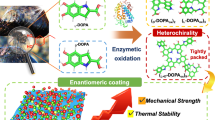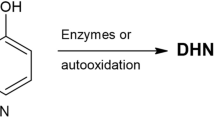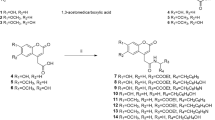Abstract
DURING the course of investigations of the mechanism of action of mushroom polyphenoloxidase, it has been possible to show the presence of an intermediary compound (X) deriving directly from dihydroxyphenylalanine (DOPA)-quinone, which is not an indole derivative and is capable of giving rise to the formation of the intermediary pigments typical of the process of melanogenesis in vitro.
This is a preview of subscription content, access via your institution
Access options
Subscribe to this journal
Receive 51 print issues and online access
$199.00 per year
only $3.90 per issue
Buy this article
- Purchase on SpringerLink
- Instant access to full article PDF
Prices may be subject to local taxes which are calculated during checkout
Similar content being viewed by others
References
Kertesz, D., and Zito, R., Nature, 179, 1017 (1957).
Rolland, M., and Lissitzky, S., Biochim. Biophys. Acta, 56, 83 (1962).
Arnow, L. E., J. Biol. Chem., 120, 151 (1937).
Lissitzky, S., and Roques, M., Bull. Soc. Chim. Biol., 39, 521 (1957).
Senoh, S., Witkop, B., Crevelling, C. R., and Udenfriend, S., J. Amer. Chem. Soc., 81, 1768 (1959).
Author information
Authors and Affiliations
Rights and permissions
About this article
Cite this article
LISSITZKY, S., ROLLAND, M. New Intermediate of Melanogenesis in vitro. Nature 193, 881–882 (1962). https://doi.org/10.1038/193881a0
Issue date:
DOI: https://doi.org/10.1038/193881a0
This article is cited by
-
�ber melaninbildende St�mme von Pseudomonas aeruginosa
Archiv f�r Mikrobiologie (1969)
-
Zur Struktur und Herkunft des Pigmentes bei der Melanosis coli
Virchows Archiv Abteilung A Pathologische Anatomie (1969)
-
Biosynthesis of alkaloids. on the transformation of tyrosine to 3,4-dihydroxyphenylalanine inPapaver somniferum L. plants
Experientia (1965)



